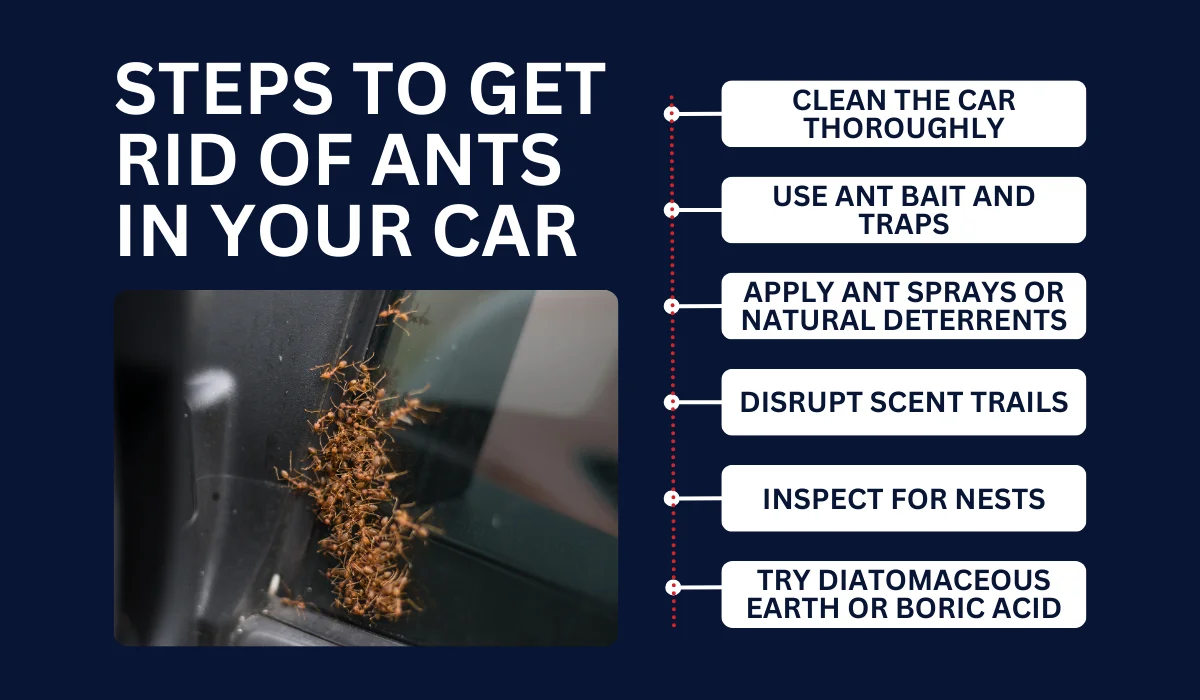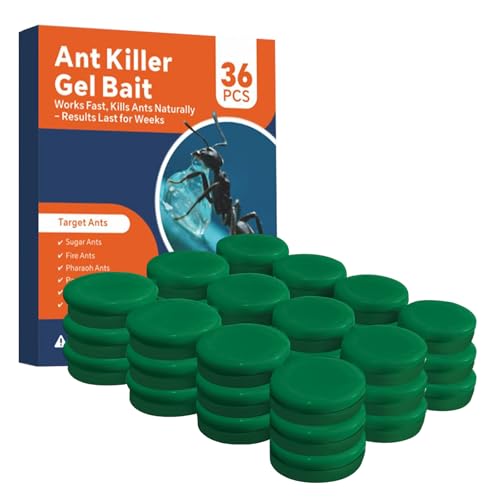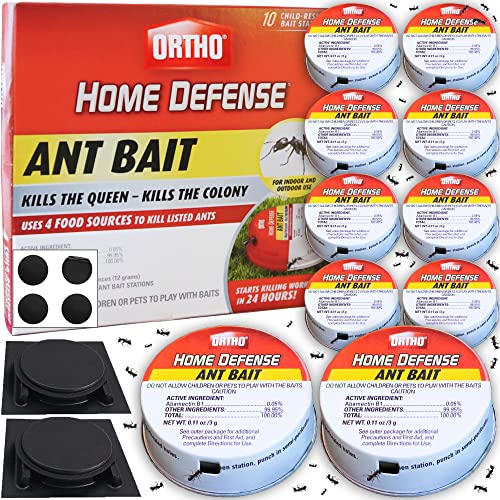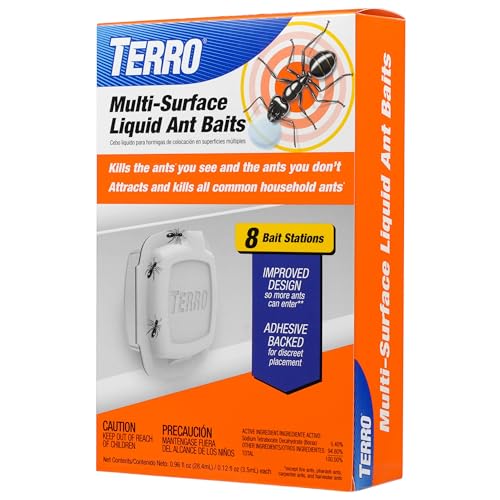Finding a line of ants marching across your dashboard is more than just a nuisance—it’s an invasion of your personal space. You’ve likely found yourself asking why these tiny pests chose your car out of all places, and more importantly, how you can evict them for good. You’re not alone in this frustrating experience; an ant infestation in a car is a common problem that can escalate quickly if not handled correctly.
Getting ants out of a car requires a comprehensive strategy that involves meticulously cleaning the interior to remove all food sources, using targeted ant baits to eliminate the colony at its source, disrupting their invisible pheromone trails, and implementing preventative habits to keep them from ever returning.
This guide breaks down the proven, multi-step process for reclaiming your vehicle. We’ll explore why the ants are there in the first place, provide a detailed action plan for their removal, and give you the long-term strategies to ensure your car remains an ant-free zone. Leveraging extensive analysis of common infestation patterns and established pest control methods, this guide provides the critical insights you need to effectively handle this problem.
Key Facts
- Primary Attractants: The main reasons ants invade a vehicle are for easily accessible food and water sources. According to multiple authoritative sources, even minuscule crumbs or a single forgotten soda can be enough to trigger an infestation.
- Pheromone Trails: Once a scout ant finds food, it lays down a chemical pheromone trail. This invisible highway guides the rest of the colony directly to the source, which is why a few ants can quickly become hundreds.
- Potential for Damage: While mostly a nuisance, some species, like the Argentine ant, are known to infest and nest within a car’s electrical components. Well-established research indicates this can potentially lead to shorts and costly damage.
- Baits vs. Sprays: Evidence strongly suggests that ant baits are far more effective than sprays for vehicle infestations. Baits are carried back to the nest, eliminating the entire colony, whereas sprays only kill the ants you see and can leave harmful residues.
- Parking Location Matters: Industry analysis often indicates that parking near an ant hill, under trees where ants forage, or over grassy areas significantly increases the risk of an infestation.
First, Understand Why Ants Are Invading Your Car
Ants infest cars primarily for accessible food and water, leaving behind pheromone trails for others to follow. They also enter vehicles for shelter or if parked near an existing nest. Ever wondered how a tiny crumb you can’t even see turns your car into a five-star restaurant for an entire ant colony? It’s simpler than you think. Understanding the root cause is the first step in knowing how to get ants out of a car effectively.
Based on common findings from pest control experts like Orkin and automotive resources, the primary reasons are:
- Food and Water Sources: This is the number one cause. Spilled soda, fast-food wrappers, fallen fries, sticky candy residue, or even a child’s forgotten snack in their car seat are powerful magnets for ants.
- Shelter: A car offers excellent protection from predators and harsh weather conditions like extreme heat or heavy rain. Ants may seek refuge inside your vehicle, especially if it’s parked for extended periods.
- Proximity to a Nest: If you consistently park near an ant hill, under a tree with a foraging trail, or in a wooded area, you are essentially providing a convenient bridge for them to explore your vehicle.
- Habit and Exploration: Scout ants are always on the lookout for new resources. If food was found in your car once before, they may return out of habit to check again, even if the food source is gone.
What Attracts Ants Even Without Obvious Food?
Even without visible food, ants enter cars for shelter, out of habit from past food discoveries, or by following pheromone trails left by scout ants. It can be incredibly confusing to find an ant infestation in a car when you keep it meticulously clean.
Here’s the deal:
The problem often lies with what you can’t see. Ants have other motivations besides a visible feast. Key factors include exploratory behavior, where scout ants simply wander into new territories, and seeking shelter from harsh weather. However, the most significant factor is often the presence of lingering pheromone trails. A single ant that found a sticky spot from a spill weeks ago could have left a chemical “map” that other ants are now following.
Pro Tip: Even a forgotten soda bottle or a sticky spot from a past spill can be a powerful magnet for ants long after the ‘food’ is gone.
Step 1: Your Complete Guide on How to Get Ants Out of a Car
A thorough, multi-step process is essential: meticulously clean the interior, relocate the car, wash the exterior, use targeted baits, disrupt pheromone trails, and check for nearby nests. Simply vacuuming or spraying the ants you see will not solve the problem. You need a systematic approach to remove the current invaders and destroy their support system.
Ready to reclaim your car? Follow these steps precisely for the best results.

:max_bytes(150000):strip_icc()/how-to-get-rid-of-ants-in-your-car-5199318-Final-8fa3586e904b4c72a49eeac2827dff23.jpg)
Sub-Step A: Relocate and Deep Clean Your Vehicle’s Interior
Move your car away from any visible ant hills. Then, meticulously vacuum every surface, crack, and compartment to remove all food debris and existing ant trails. This is the most critical step because it removes both the attractant (food) and the ants’ navigation system (pheromones).
First, move your car to a new spot, preferably on pavement and away from trees or grassy areas. Then, begin the deep clean:
- Remove All Trash: Take out every food wrapper, empty bottle, old receipt, and piece of clutter.
- Vacuum Everything: Use a powerful vacuum with a crevice tool to get into every nook and cranny.
- Vacuum the floor mats, and then remove them and vacuum the floor underneath.
- Thoroughly vacuum all seats, paying special attention to the seams and cracks.
- Don’t forget to vacuum under the seats and around the seat rails.
- Clean out the glovebox, center console, and any door pockets.
- Vacuum the trunk completely.
- Wipe Down Surfaces: Use a quality interior cleaner to wipe down the dashboard, console, door panels, and any other hard surfaces to remove sticky residues and pheromones.
Pro Tip: Don’t forget the hidden spots! Check under child car seats and in the trunk’s spare tire well—ants love to hide there.
Sub-Step B: Wash the Exterior and Undercarriage
Give your car a thorough exterior wash, paying special attention to the tires, wheel wells, and undercarriage to remove hidden ants and their guiding pheromone trails. Ants often climb up through the tires to gain entry, and they can leave external trails that guide new ants to your vehicle.
Focus on these key areas:
1. Tires: Spray the tires thoroughly. Ants can hide in the treads.
2. Wheel Wells: This is a primary entry point and hiding spot. Clean this area aggressively with a high-pressure hose if possible.
3. Undercarriage: Wash the bottom of the car to remove any ants or trails that might be clinging there.
Think of this as erasing the treasure map leading ants to your car.
Sub-Step C: Deploy Ant Baits to Eliminate the Colony
Strategically place ant bait stations (like Terro gel) where you see ants. The workers will carry the poison back to the nest, eliminating the problem at its source. This is the step that actually kills the colony, not just the foragers in your car. Avoid using bug sprays or foggers, which can leave toxic residues and fail to address the root cause.
Place baits where they won’t be disturbed but are in the ants’ path.
| Placement Area | Why It Works |
|---|---|
| Under Seats | High-traffic, low-disturbance area for ants. |
| In Cup Holders | A common area for spills and ant activity. |
| Along Door Panels | Follows ant entry points and pathways. |
| In the Trunk | Place near corners or where activity is seen. |
Quick Fact: Ant baits work by turning worker ants into unknowing couriers, delivering the poison directly to the queen and destroying the colony from within.
A crucial tip from pest management professionals is to allow the ants to feed for a few days. You will see an initial increase in ant activity as they swarm the bait. This is a good sign! It means they are taking the poison back to the nest. Resist the urge to clean them up until the activity dies down completely.
Sub-Step D: Use Natural Deterrents to Disrupt Ant Trails
To disrupt ant trails naturally, spray a mix of water and peppermint oil, use citrus-based cleaners, or lightly sprinkle food-grade diatomaceous earth under floor mats. These methods are great for ongoing prevention and for cleaning surfaces after the baits have done their job. They work by scrambling the ants’ ability to follow pheromone signals.
- Peppermint Oil Spray: Mix 10-15 drops of peppermint essential oil with water in a spray bottle. Lightly mist areas where you’ve seen ants, like along door sills and under the dash. Ants despise the strong scent.
- Citrus-Based Cleaners: Use cleaners with orange or lemon oil to wipe down interior surfaces. This not only cleans but also leaves a scent that naturally repels ants.
- Diatomaceous Earth: For a non-liquid solution, lightly sprinkle food-grade diatomaceous earth under your floor mats and in the trunk. This natural powder is made of fossilized diatoms and works by dehydrating insects that walk through it. It is harmless to humans and pets but lethal to ants.
Troubleshooting: How to Handle Ants in a Car Dashboard or Engine
For ants in hard-to-reach areas like the dashboard or engine, baits are still the best strategy. Avoid spraying liquids. If the problem persists or you suspect a nest in the car’s structure, it’s time to call a professional. Seeing ants crawl out of your vents or finding them in the engine bay is alarming. Here’s how to approach these tough situations.
What if ants are inside the dashboard?
This is a prime location for certain species, like the Argentine ant, which are attracted to electrical components. Do not spray any liquids or powders into your vents or electronics. This can cause serious damage. Instead, place gel ant baits on a small piece of cardboard near the vents or along the edges of the dashboard where you see them emerging. They will find the bait and carry it back to their hidden nest.
What about ants in the engine bay?
Ants may nest in the engine bay for warmth and shelter. A nest here can be a serious issue. Again, avoid spraying chemicals directly on the engine. The best approach is to place bait stations in safe, secure locations within the engine compartment, away from moving parts and hot surfaces. If you see a physical nest, or if the baiting strategy doesn’t work after a week, it is strongly recommended to contact a professional.
Step 2: Implement Long-Term Prevention to Keep Ants Out for Good
To prevent ants from returning, regularly vacuum your car, immediately clean spills, be mindful of where you park, and consider using an exterior barrier spray on tires. You’ve done the hard work of getting them out. Now, let’s make sure they never come back. Prevention is about making your car as uninviting as possible.
- Maintain Cleanliness: This is your best defense. Vacuum your car’s interior at least once a week.
- No Food Left Behind: Make it a strict rule to remove all food, drink containers, and wrappers from the car at the end of each day. Avoid eating in the car if possible.
- Clean Spills Immediately: Keep a small cleaning kit with interior wipes in your car to tackle spills right when they happen.
- Park Smart: Be conscious of your parking spots. Avoid parking directly on top of or next to visible ant hills. Try to park on pavement rather than grass or dirt when possible.
- Use a Barrier: Some expert sources recommend periodically using an exterior insect barrier spray on your tires and wheel wells to create a repellent shield.

Step 3: Know When to Call a Pest Control Professional
If the infestation is severe, persists after trying these methods, or you suspect a nest is hidden deep within the car’s structure (like door panels), contact a pest control professional immediately. There is no shame in calling for backup. Some infestations are too entrenched for DIY methods.
You should call a professional when:
* You have tried cleaning and baiting for over a week with no decrease in ant activity.
* You see a large number of ants coming from inaccessible areas like inside door panels, the headliner, or deep within the dashboard.
* You physically see a nest built within the vehicle’s structure.
* The ant species is known to be particularly destructive, like carpenter ants or fire ants.
Pest control experts can identify the specific species and use targeted, professional-grade treatments that are safe for vehicles, such as special insecticide-impregnated plastic strips that can be placed in the car overnight to eliminate the colony without leaving a residue.
For a reliable and powerful solution to your ant problem, consider investing in high-quality ant bait traps. These products are designed to be placed strategically within your car and work by allowing worker ants to carry the poison back to their nest, ensuring the entire colony is eliminated.
FAQs About How to Get Ants Out of a Car
What happens if ants get in your car?
While mostly a nuisance, some ant species (like the Argentine ant) can nest in and damage electrical components, making removal important. For most species, the primary issue is the annoyance and unsanitary condition of having insects crawling around. However, the potential for them to chew through wires or cause short circuits means any car ant infestation should be taken seriously.
How long does it take to get ants out of a car?
Initial cleaning provides immediate relief, but using baits to eliminate the entire colony can take a few days to a week for full effectiveness. You will see a significant reduction in ants after a thorough cleaning. However, for the bait to be carried back and wipe out the queen and nest, you must be patient and allow the process to work over several days.
Why are there small black ants in my car?
Small black ants, like most ants, are in your car for the same reasons: seeking food, water, or shelter. The size or color of the ant doesn’t typically change the reason for their presence. They are following the scent of something appealing. The comprehensive removal process outlined above is effective for most common types of household ants, including small black ones.
Are ant bombs or foggers safe to use in a car?
No, it is not recommended to use bug sprays, bombs, or foggers inside a car. They leave behind residues, create strong odors, and fail to eliminate the colony, unlike targeted baits. These products are not designed for the confined, enclosed space of a vehicle and can permeate upholstery and ventilation systems with chemicals, while the root of the problem—the nest—remains untouched.
Final Summary: Your Action Plan for an Ant-Free Car
You now have the complete, expert-informed strategy to conquer the ant invasion in your car. By understanding that the battle is won by eliminating their food, destroying their communication trails, and taking out their colony at its source, you can tackle the problem with confidence. This isn’t about just killing the ants you see; it’s about systematically dismantling their entire operation.
Remember the most critical takeaways for success:
- Clean Thoroughly: Your first and most powerful weapon is a vacuum cleaner and interior wipes. Removing every last crumb and sticky residue eliminates the primary reason ants are there.
- Bait Strategically: Use high-quality ant baits and have patience. This is the only DIY method that ensures you eliminate the queen and the entire hidden nest.
- Prevent Relentlessly: Once they’re gone, keep them gone. A clean car and smart parking habits are your ticket to a permanently ant-free driving experience.
You now have the complete, expert-informed strategy. Take back your car with confidence, starting today
Last update on 2025-11-27 / Affiliate links / Images from Amazon Product Advertising API













